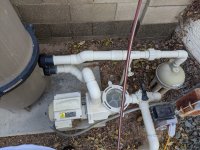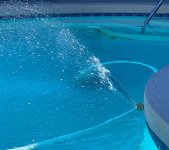Can you explain this more? Or point me to some resources? I'm not sure how Id do that. There is a timer by the pump but I don't think it's doing anything currently. Would I sync that timer with my pool pump run times?
Yes, that can work, assuming the timer is in OK condition. That timer was probably running the previous pump, before it was replaced with your current one that has its own onboard timer.
Typically, you don't need much pump runtime. Even just a few hours can mix up your chemical additions well enough and filter the water clear enough. But once you install the SWG, that will govern pump runtime, because they need a good many hours a day to make enough chlorine. 6-12 is not unusual, sometimes more. So you set the pump's RPMs to provide just enough flow for the SWG (there will be a minimum required), and then you adjust the SWGs output (how much chlorine it makes per hour) and the pump's runtime to make enough chlorine. With such a simple set up, you would most likely set the SWG at or near 100% output, and then just adjust the pump's hours to give you the chlorine you need. Others here run their pump 24/7, and lower the SWG output way down, so that their pool receives chlorine 24/7. No right or wrong about that, just personal preference. I digress.
Regardless of the pump's runtime, the SWG must function only within the pump's schedule. Without automation, you need to run the SWG from a reliable timer (like maybe the one you have). You just set the SWG to come on a little after the pump starts, and go off a little before the pump run is over. I say "little" for three reasons. (1) You want the water to be flowing well before the SWG starts producing. Sometimes the pump needs to prime. (2) You want the pump to run a for a few minutes after the SWG is done. This isn't critical, but might as well flush out all that chlorine goodness to the pool before shutting down the pump. And (3), most importantly, you want to give the timer some wiggle room, especially if it's one of those Intermatic timers that use the little mechanical set-screw tabs to set on and off times. Those timers are fairly reliable, but not terribly accurate, so you want to make sure you leave yourself a margin of error in case the mechanical timer for the SWG gets out of sync with the much more accurate timer inside the pump.
You'll need to schedule periodic checks of the SWG timer, to make sure it is running, and running on time, and running as scheduled. And if it is the type that loses time when the power goes out, then you'll need to monitor that, too. Remember, the timer is part of a two-pronged safety system. You can see, neither (the flow sensor nor the timer) are particularly fail-proof, which is why you need both, in case either fails, the other will do its job.





